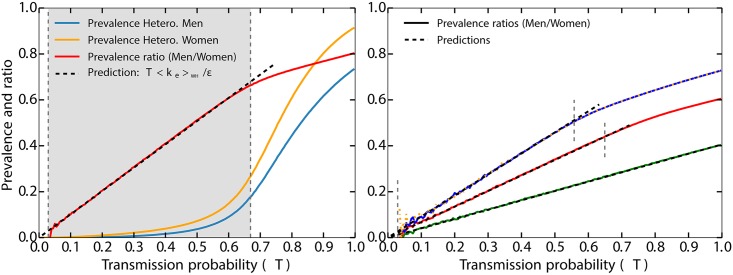Fig 3.
left panel: Validation that the ratio of incidence in heterosexual men and women equals T〈ke〉WH/ε, as predicted in the main text using the same results of numerical simulations as for the right panel of Fig 2. The blue and yellow solid lines show the prevalence of ZIKV within the heterosexual men and women sub-populations, and the red solid line shows their ratio. The vertical gray lines and shaded area are the same as on the right panel of Fig 2. right panel: The black dashed lines show the different predictions for the prevalence ratios. The green solid line shows the results of the numerical simulations for the ratio using ε = 5 while keeping the same values for 〈ke〉WH and 〈ke〉MH as in the left panel (respectively 2.03 and 2.20). The red solid line shows the results for ε = 3, an increased value of 〈ke〉MH (3.51) and an unchanged value of 〈ke〉WH. Notice how the slope increases by a factor 5/3. The blue solid line shows a similar scenario as the red one, but one where 〈ke〉WH has also been increased (2.75), thus yielding a steeper slope. Finally, the orange dotted line (almost completely under the blue one) shows the same scenario as the blue line, but one in which the average excess degree of bisexual men has been increased (from 5.40 to 7.72 without any effect, as predicted). The vertical dashed gray lines show the different thresholds corresponding to their respective R0 equals 1 (see Eqs (1) and (2)). Altogether, these results confirm that 〈ke〉WH and T/ϵ are the only quantities affecting the risk factor of heterosexual women compared to men.

